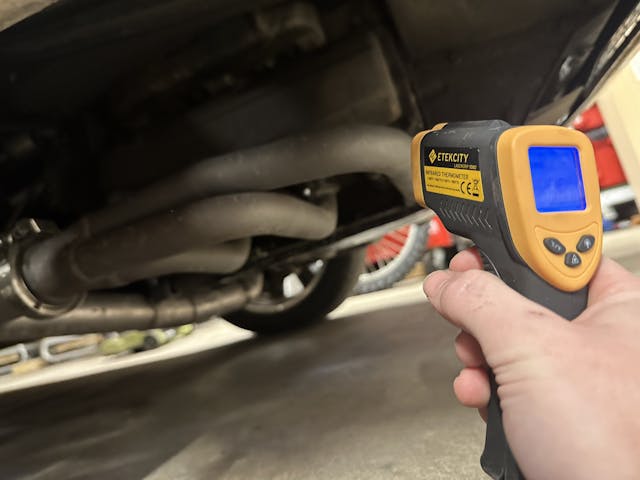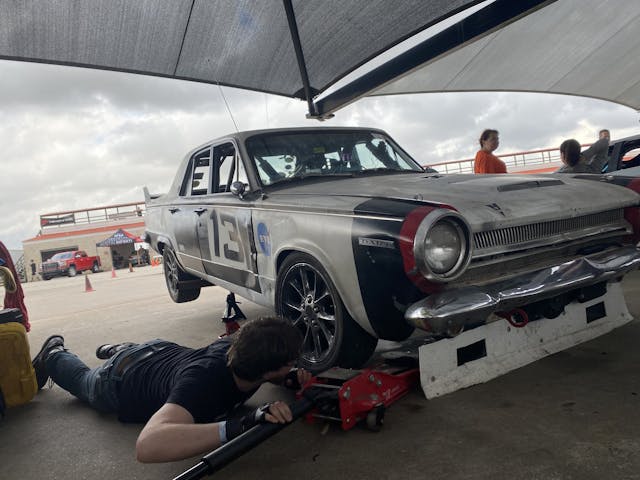6 Diagnostic Tools Every DIY’er Needs
Working on cars and trucks is often a mix of necessity and curiosity. The combination of “this needs to be fixed” and “I bet I can fix this” has gotten more than a few people in over their heads due to swiping credit cards and replacing parts that logic says are faulty even when that’s not the case. The key to good DIY mechanic work is diagnostics: everything else is just parts replacing.
If you want to save time, money, and frustration while getting your cars back on the road safely there are a handful of tools that will help stack the deck in your favor. Make sure these are in your tool box—and you know how to use them—to ensure your next breakdown will only be with the car and not your mind.
Compression Tester

The darkhorse in the four-stroke cycle is the squeeze that comes before lighting off the air and fuel mixed in the chamber. Compressing the air/fuel mixture increases the power potential, but if your engine is unable to properly compress the mixture the engine won’t run properly. Knowing how much squeeze your engine has is a very helpful diagnostic data point as often we don’t have the ability to peek inside an engine easily or without a parts bill that may or may not help the initial problem and could potentially create another.
Leak Down Tester
A compression tester will tell you if you are losing the squeeze, but a leak down tester is more likely to tell you where. Using a compressor rather than piston and crankshaft to provide the pressure in the cylinder, we are able to see exactly how much is escaping and also try and get a feel for where. Use a leak down tester to pressurize the cylinder and listen or feel for leaks from the valves by paying close attention to the intake and exhaust tract. Look for bubbles or changes in coolant level to see if the pressure is escaping the head gasket into the cooling system.
Multimeter
Despite having never met someone who enjoys diagnosing electric gremlins, there are a lot of us who do take the time to suss out why the magical pixies using the copper highways of our wiring harnesses are struggling with a traffic jam or road closure.
Electrical issues often are tough to find but rewarding when solved. Understanding your electrical system and using a shop manual to aid in properly testing various components can save hours and hours worth of headaches and weeks of waiting on parts that may or may not fix the problem at hand. If you find electric work is not terrifying, consider grabbing a power probe for additional diagnostic superpowers.
Vacuum gauge


Leaks on the intake side of the engine can cause all kinds of havoc and strange running conditions. Knowing the vacuum in the intake manifold can tell one a lot in terms of engine health. Ask anyone who has set the ignition timing of an engine by using a vacuum gauge. Spikes or other erratic movements in vacuum on a running engine can point to valves that aren’t sealing properly, intake leaks, and even clogged vacuum passages inside manifolds.
Infrared thermometer

Locating parts that may be hot that shouldn’t be, or vice versa, can be very telling when investigating the condition and health of an engine. I’ve used an instant read thermometer to diagnose lean-running cylinders and clogged passages in a radiator by looking for cool spots in what should normally be evenly warm. Sometimes just touch is enough, and other times a spritz of water might tell you just as much, but having an accurate measurement can be wonderful for comparison and these termometers have only been getting more affordable in recent history.
OBD Scan Tool

Cars are more connected than ever and even if your fun to drive car is not very connected, your daily driver likely is. Scan tools that use the on board diagnostics ports found under the dashboard on most modern vehicles can be a very efficient way to narrow down where to start doing actual diagnostics and inspection since often times these tools talk in codes that can be awfully vague or mixed considering it’s called on board diagnostics. To be fair, every diagnostic tool is only powerful when used and interpreted correctly.



You missed the prime tool today.
A lap top or pad. The internet is your service manual anymore. It can find, disgnose and repair nearly any issue today. Be it forums and video.
You can pull a code up but sone readers still don’t tell you what it is. Take compression test but what is acceptable? Look it up in the web.
YES!! Even if I’ve done it before usually check on line anyway.
👍
The internet is NOT a service manual and never will be. There are too many opinions clouding actual factory specifications. Tread lightly.
Multimeters are nice but they can be misleading. Make a test light – I mean an actual 12V in a socket with leads on it, and here’s why. In my mechanicking days, I used to run across what I called green wires… wires that are green on the inside, not on the outside. The insulation would get a nick in it, and road salt would start eating the wire from the inside out. The thing about it is when you test the circuit with a multimeter – if it hasn’t completely failed, you may still get something in the 12V range. Put a real load on it with a 12V bulb and often it would tell you the story the multimeter didn’t. The pen ones they sell in the auto parts store don’t draw enough amps to be reliable in this scenario.
Yup when testing for a non working circuit a good old fashioned incandescent test light is the thing you need. Well unless you are working on the 5v computer circuits. There are now some add on tools for your DMM that includes an internal load resistor to load the circuit and allow you to measure the voltage drop across that load but of course you can just do that with your test light for a lot less money.
If you don’t know how to use a multimeter, just say so. Multimeter can test resistance and tell you exactly how corroded a given wire is.
When you are working on a 53 foot trailer, and your test leads aren’t quite that long, the light works better
I don’t think using a very specific use case that doesn’t apply to most users is a great argument. It is very cope of you, to quote the youths.
No that will often give false positives, plus it is much harder to do for many circuits.
randy ol’ jar, yes, a typical multi meter measures circuit resistance. but sometimes, even a corroded wire will show zero ohms and load test needs to be performed, which is what tg was explaining. an incident circuit may check out ok with the meter, yet fail a load test. if a wire has been severed down to 1-2 strands, it might be ok if it was for a sensor on a 5v reference circuit (there is no load on this type of circuit). If there was a load on that severed circuit, such as a radiator fan, the fan would barely run if at all. so, as tg was explaining, when a load is put on that circuit, for example, wiring up two 1157 type brake bulbs in parallel, they would not fully light up.
Exactly right. Measuring resistance with no load is useless. The light provides the load. Internet Nannie’s are insufferable sometimes.
Similar to testing a car battery with a voltmeter. It can show 12.3 volts and be unable to illuminate a dome light bulb. It takes a load tester to show the battery is dead.
When I went to D-Jet school in 1979, the first thing the instructor showed us was the simple test light. He held it up, asked if we all had one, and then said “…before you blame the computer…”
1970, not ’79 Fat Finger time.
Sign me up for D-Jet school 😉
Yeah, me, too. My Volvo 142E would love it if I knew more about it.
Haha, absolutely! Test lights are your “scope on a rope”!
And to add a technique to this, a “voltage drop” test will accomplish the same thing as the test light if you don’t have one handy. If your load isn’t dropping close to the full 12 volts, there’s an issue, maybe some of that “green death” on a wire up or down stream in the circuit.
Exactly. Some cave people would rather waste time trying to interpret “light dim” rather than dealing with an accurate measurement for the same amount of effort.
An inexpensive mechanics stethoscope (HF $7.99) can help locate some problems. I had a noise that I thought for sure was coming from the water pump. I used the stethoscope and quickly determined that it was from the alternator.
Or a flat-tip screwdriver held up to your ear… the old school trick
I bought a mechanics stethoscope at a “clear-out overstock and returned goods” store just today – for a quarter. My guess is that the people sorting through those bins just flat didn’t know what it was for – or thought that it was missing something that a normal medical device would have. I dunno, but I was happy to find it!
EXCELLENT article, Kyle, with some great info.
Keep ’em coming.
You haven’t met me. I’ve been fascinated with electricity and electronics my entire life which explains my career choice of electrical engineering. Figuring out electrical problems is definitely fun for me!
Hey, wanna be BFFs? C’mon over to my shop sometime soon and I’ll see to it that you have all the fun you can handle! 😂
You missed the most valuable tool of all for a no start condition. A can of ether. The absolutely quickest way for deciding if its ignition or fuel.
Or an old spray bottle full of gasoline for those folks who aren’t too crazy about ether. You just have to flush the sprayer out after each use or it won’t work the next time.
If Cosby sauce killed engines, how come old diesels (especially HD applications) had ether injection systems from the factory? Spray bottle of gasoline is fine if you have the stuff laying around, otherwise, give ‘er the juice!
Friends holding coil wire while you crank are a great way to check for spark although it seems they only work one time for some reason and aren’t friends any more if you don’t hurry and give them some adult beverage.
Bore or endoscope invaluable for that “dropped” part in the dark internals of the engine. Or to check where no man can go.
Electrical problems… five hours to find, five minutes to fix. Yuck!
Can’t believe they would leave out a torque wrench!
Okay, you stumped me. After thinking about this for a couple minutes I’m blanking on how a torque wrench would be used for diagnostics.
You’ve never banged a heavy object close at hand to see if that fixes the problem?
My OBD2 bluetooth code reader and my phone has been very helpful for finding issues.
Yes! I have one, and it has been a life saver, if for no other reason than allowing me to clear codes. My wife’s stupid daily driver Chevy HHR has this “thing” where the thermostat doesn’t seal correctly, and it causes the engine to warm up too slow, which in turn causes the computer to turn off the air conditioning and the temperature gauge (I’d like to hear the software engineer’s logic on that!). Im not sure the car is worth the effort to replace the thermostat, but my Bluetooth code reader lets me clear the code with my phone.
Can’t seem to find the OBD port on my 1967 GTO. Any idea where it might be?
Dog gone, looked under the passenger seat of my 68 Camaro and found my OBD port, but then… the LS 3 under the hood needs it
One of my best diagnostic tools is my grandson – my 70 year old ears don’t hear noises as well as his do.
Got the same problem, US Navy engine room took that away!
I’m still looking for that OBDII connector on my 1940 International D2 pickup truck…
LOL!! I can’t find one in my 41 Ford coupe either and Google hasn’t been any help.
I was thinking similarly about by 60s Fiats. “Harumph, I say. If you’re using an OBD, you’re not diagnosing. You’re just downloading the diagnosis.”
Electrics are EASY if you understand them. Besides, a 10 amp fuse is a lot easier to lift than a Hemi V-8. Cleaner, too.
I look for problems anywhere there are high current circuits and parts that switch them – for instance starter solenoids and relays. Then I look for corrosion on contacts and in terminal blocks. Then I look at anything that moves and carries current, such as license plate wires where the wires run through or near the trunk or hatchback hinges. Power windows controlled from the driver’s door are especially good for problems, that harness gets flexed every time anyone opens or closes that door.
Learn to read schematics – they are a ROAD MAP of the wiring in your vehicle, the wires are different colors for each circuit. That means if the turn signals aren’t working, you won’t waste time tracing the power to the radio. (If the turn signals aren’t working, check the flasher, then the bulbs, and the sockets for corrosion and bad grounds.)
It helps if you are small and agile, because sometimes you’ll need to get into positions the Kama Sutra never even imagined in order to (for instance) access wiring under the dash. If you are a 300 pound linebacker, well, you’ll have some problems there.
When you do work on electrics, if someone has used friction tape and those blue squeeze-on connectors, you are probably looking at a complete rewire. Friction tape gets gooey and comes off, and the squeeze-on connectors puncture the insulation and cut some of the conductors inside, which is a 24 karat invitation to major electrical problems real soon now. Do it right or don’t do it.
Don’t be afraid of electrics – knowledge is power (pun intended?).
Best Regards
“Eledtronics are easy if you understand them” is a quote that will ring down through the decades. EF, anything is easy if you understand it; or am I missing something significant here?
I have a couple of degrees and three teaching credentials, and I still have problems with some subjects: math is one, and electronics is another. Wouldn’t be surprised it they are related in my misfiring brain! I just bought a new multimeter and a good book on automotive electronics, and I begin to think at age 79 the subject has defeated me; I’ll just have to pay the price for a person ‘who understands it’ to get me through the tough spots, and keep on doing body/paint, where I excel! Different strokes for different folks? Right brain vs. left brain?
People have aptitudes (my whole career in working with little kids confirms that, at least) and I often amazed at the gifts some folks have but the vulnerabilities/weaknesses that go along with those aptitudes.
I do beautiful wiring; careful, clean, and looking well-organized; it’s just that some times ‘it don’t work’! Wick
The Internet and membership on a Forum with knowledgeable people willing to help! The pad or computer answer kind of covers that. Facebook groups are ok for quick answers sometimes, but I belong to several and I just hate typing a long answer only to have someone ask the same question a week or two later. Have to type it all over again, can’t just point to the previous post.
One thing though, if you don’t really know how to use ANY of the tools mentioned, they aren’t doing you any good!
I can’t even change a wheel bearing cuz the axle shaft is too close to the bolts or vise versa